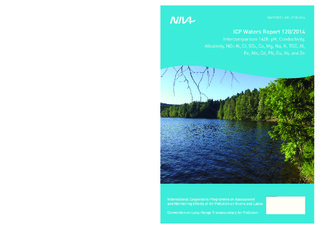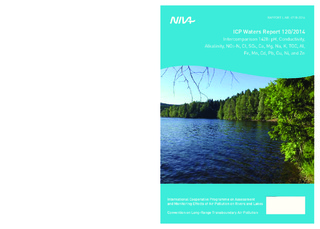| dc.contributor.author | Escudero-Oñate, Carlos | |
| dc.contributor.other | Escudero-Oñate, Carlos - Project manager | |
| dc.contributor.other | Escudero-Oñate, Carlos - Project manager | |
| dc.date.accessioned | 2014-09-26T08:06:04Z | |
| dc.date.accessioned | 2014-10-01T10:57:01Z | |
| dc.date.available | 2014-09-26T08:06:04Z | |
| dc.date.available | 2014-10-01T10:57:01Z | |
| dc.date.issued | 2014-09 | |
| dc.identifier | 6718 | |
| dc.identifier.isbn | 978-82-577-6453-1 | |
| dc.identifier.issn | 1894-7948 | |
| dc.identifier.uri | http://hdl.handle.net/11250/222581 | |
| dc.description.abstract | In the current edition of the ICP Waters Intercomparison program, 64 laboratories were invited to participate. 33 from 12 different countries accepted the invitation and all the participants submitted results to the Organization. Two sample sets were prepared: one for the determination of major ions and one for heavy metals. This year a slightly acidic sample was prepared to make the intercomparison more relevant for monitoring of acidic waters. The samples of the set AB where slightly spiked with hydrochloric acid to get a pH close to 6. The detailed procedure is described in Appendix B of the document. Based on the general target accuracy of 20 % or the special accuracy limit for pH and conductivity ( 0,2 pH units and 10 % respectively),76 % of the overall results were considered acceptable. This is slightly better than last year, but in line with previous editions. The best results were reported for the analytical variables: conductivity, chloride, calcium, potassium and sodium, with acceptances of 90% or higher.
The lowest percentage of acceptable results was observed for alkalinity and nitrate+nitrite-N, where only 26 and 14% of the reported results were acceptable respectively. As observed in earlier intercomparisons, nitrate showed clear signs of unstability and a large variation in values were reported from the participating laboratories. Harmonization of the analytical methods used and of the practical procedures followed, may be the most important way to improve the comparability for these parameters. | nb_NO |
| dc.description.sponsorship | Norwegian Environment Agency | |
| dc.description.sponsorship | United Nations Economic Commission for Europe (UNECE) | |
| dc.language.iso | eng | nb_NO |
| dc.publisher | Norsk institutt for vannforskning | nb_NO |
| dc.relation.ispartofseries | NIVA-rapport;6718 | |
| dc.relation.ispartofseries | ICP Waters report;120/2014 | |
| dc.rights | Navngivelse-Ikkekommersiell-DelPåSammeVilkår 3.0 Norge | * |
| dc.rights.uri | http://creativecommons.org/licenses/by-nc-sa/3.0/no/ | * |
| dc.title | Intercomparison 1428: pH, Conductivity, Alkalinity, NO3-N, Cl, SO4, Ca, Mg, Na, K, TOC, Al, Fe, Mn, Cd, Pb, Cu, Ni, and Zn (ICP Waters report 120/2014) | nb_NO |
| dc.type | Research report | nb_NO |
| dc.date.updated | 2014-09-26T08:06:05Z | |
| dc.rights.holder | Norsk institutt for vannforskning/Norwegian Institute for Water Research | |
| dc.subject.nsi | VDP::Matematikk og naturvitenskap: 400 | nb_NO |
| dc.subject.nsi | VDP::Mathematics and natural scienses: 400 | nb_NO |
| dc.source.pagenumber | 82 | nb_NO |
| dc.identifier.cristin | 1158365 | |
| dc.subject.keyword | Kvalitetskontroll / Quality Control | |
| dc.subject.keyword | Overvåking / Monitoring | |
| dc.subject.keyword | Prøvningssammenligning / Intercomparison | |
| dc.subject.keyword | Sur nedbør / Acid Rain | |
| dc.relation.project | 10300 | |


